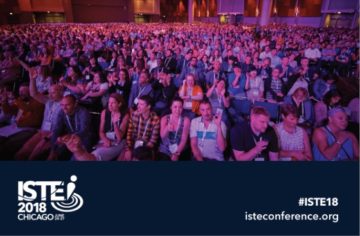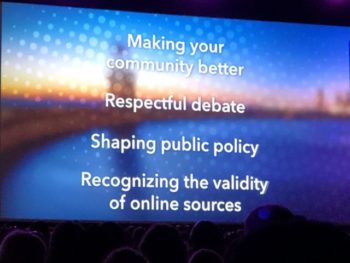THIS JUST IN: In a historic development for the Internet and its users under 18, the Council of Europe today adopted a Recommendation – a comprehensive set of guidelines to European Union member states – for upholding children’s rights in digital environments, their rights as digital citizens. “How to better protect and empower children as rights-holders… is at the core of the new Recommendation,” the COE announced after I posted the following…
It has been a big year for digital citizenship, and what better time – at least here in the United States – to check in on its practice than this July 4th week, one year since the Obama Foundation issued a call to look more deeply into its meaning (here‘s what they heard from us)? I was interested to see that not only did digital citizenship get even more play at this year’s ISTE, the gathering of more than 24,000 ed tech educators and exhibitors from 87 countries in Chicago last week, than it did at last year’s in San Antonio. It was also the singular focus of ISTE CEO Richard Culatta’s opening remarks.
 We are progressing. I was delighted to hear Mr. Culatta say that posting appropriately online is not digital citizenship. “It’s online safety,” he said. Exactly. Telling our children and students to post respectfully and be good online is certainly better than telling them nothing, but notice that it’s telling citizens what to do. It’s top-down, hierarchical – digital dictatorship, not digital citizenship, I’d add. Digital citizenship – any kind of citizenship – is citizen-sourced. So it’s meaningful to the citizens, informed by their practice of it as their literacy grows. And (digital) citizenship’s literacy is trifold: it’s enabled by media literacy, digital literacy and social literacy, which develop with practice. So – for that practice – it must be about the agency, not the control, of the citizens (one form of control being “classroom management,” right?). And supporting that agency are the citizens’ rights – of expression, participation and association, as well as protection and provision, or education.
We are progressing. I was delighted to hear Mr. Culatta say that posting appropriately online is not digital citizenship. “It’s online safety,” he said. Exactly. Telling our children and students to post respectfully and be good online is certainly better than telling them nothing, but notice that it’s telling citizens what to do. It’s top-down, hierarchical – digital dictatorship, not digital citizenship, I’d add. Digital citizenship – any kind of citizenship – is citizen-sourced. So it’s meaningful to the citizens, informed by their practice of it as their literacy grows. And (digital) citizenship’s literacy is trifold: it’s enabled by media literacy, digital literacy and social literacy, which develop with practice. So – for that practice – it must be about the agency, not the control, of the citizens (one form of control being “classroom management,” right?). And supporting that agency are the citizens’ rights – of expression, participation and association, as well as protection and provision, or education.
Student voice & participation
So by the very nature of citizenship, including the digital kind, those who set policy for the citizenry – whether in families, classrooms, schools or governments – need the citizens’ participation, or at least voice, in the policymaking. [Seemingly in illustration of that, almost a third of ISTE’s speakers were students: 876 of them, ISTE reports.] It was a privilege to attend the Global Student Voice Film Festival at the conference, where we got to watch the winners (2-min. student-produced videos on empathy) of its 2017-’18 competition. The festival is the brainchild of the very new Student Voice Foundation, which aims to “help every student and educator believe in the power of his or her own voice to effect positive change.”

Does that not sync right up with ISTE’s definition of (digital) citizenship? The four pieces on the big screen behind CEO Culatta ISTE opening night were: “Making your community better“; “Respectful debate“; “Shaping public policy“; including the media literacy one: “Recognizing the validity of online sources.” In his remarks, he gave a shoutout to a book ISTE published last year, Digital Citizenship in Action: Empowering Students to Engage in Online Communities, by Kristen Mattson, who suggests that “digital citizenship curricula should strive to show students possibilities over problems, opportunities over risks and community successes over personal gain.” Hear, hear!
2 top sources you should know about…
That lines up with two key projects that few educators seem to be aware of, both published in 2015:
- The work on digital citizenship that was done by researchers Lisa Jones and Kimberly Mitchell at the University of New Hampshire, suggesting simple guidelines rather than whole curricula. The three guidelines they offered were to a) keep digital citizenship distinct from cyberbullying prevention and digital literacy skill development, b) focus it on “online respect and online civic engagement,” and c) align it with longstanding youth citizenship goals, a key aspect of which they highlighted from the scholarship: “the ability to move beyond one’s individual self-interest and to be committed to the well-being of some larger group of which one is a member.” Which aligns perfectly with the second major project…
- A digital ethics study at the Harvard School of Education which found that so much of what we’ve taught our children in the digital age’s first decades focused on consequences to self – the impacts of their online behavior and activities on themselves – rather than to others and their communities. They offer a digital ethics framework that helps us move beyond mere “consequence thinking” (see this for more on project director Carrie James’s book).
Clearly, we are seeing progress, as we continue to soften the focus on curricula and classroom management and move it to citizenship that’s citizen-sourced – learning to help one another, as citizens, to discover how to engage in ways that are meaningful to each of us.
Related links
- For a look at some of the research and thinking that went into the Council of Europe’s new Recommendation on youth digital rights, see “Children’s rights and digital technologies,” by Eva Lievens, Sonia Livingstone, Sharon Mclaughlin, Brian O’Neill, and Valerie Verdoodt. Here‘s a blog post by John Carr explaining the significance of the Recommendation (though his highlights feature children’s rights of protection not expression, association and participation. Carr, along with the first two authors of “Children’s rights and digital technologies,” was one of the advisers to the Council of Europe.
- “The Heart of Digital Citizenship,” my 2016 TEDxGeneva talk about the elements I mentioned above
- A 2015 post on digital citizenship’s crucial missing piece – agency – and a whole lot more on Literacy & Citizenship at NetFamilyNews.org
- “Finally defining digital citizenship: Help from top researchers” at University of New Hampshire also a 2015 post
- “Digital citizenship, the ‘lived curriculum’,” Part 1 about how it’s a disposition as much as a practice, and Part 2 about what that “lived curriculum” looks like – my 2013 posts featuring the work of Australian educator Bron Stuckey
- Mattson’s book is on backorder in the ISTE site, but it can be ordered right now at Amazon here.

[…] Signs of serious progress for digital citizenship – NetFamilyNews.org | NetFamilyNews.org […]